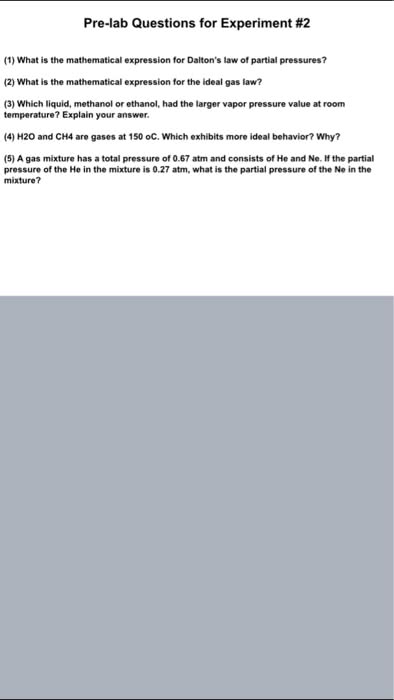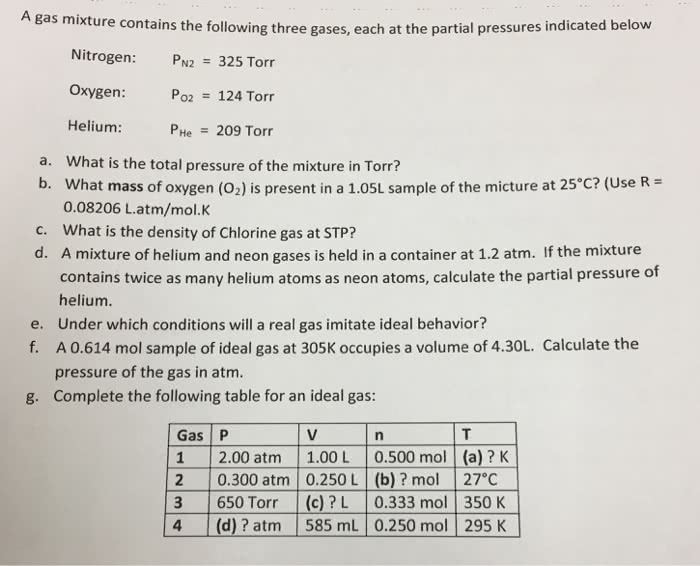Chemistry 1302A/B Chapter Notes - Chapter 1.2: Kinetic Energy, Vapor Pressure, Weighted Arithmetic Mean

!"#$%&
•
One mole of any ideal gas always occupies the same volume at a given
temperature and pressure
•
The volume of one mole of an ideal gas at
'()*+,-.(/0
and 1
123*+4'45..*6710
is
,,589
•
Variations of the Ideal Gas Law
:#;!
%&
•
<#=%&
!
•
Dalton's Law of Partial Pressures
The total pressure exerted by a mixture of gases is the sum of all the partial
pressures of these gases
!>"#$>%&
○
•
•
Vapour-Liquid Equilibrium
?@'
+
A
0
#?@'
+
B
0
•
Boiling point: temperature at which the vapour pressure of a liquid is equal to
atmospheric pressure
•
Average Molar Mass of a Mixture
The average molar mass (;;
CCCCC) of a mixture of different gases is the weighted
average of the molar mases of the diffrerent components
;;
CCCCC#+DEF;;E0G+DHF;;H0G+DIF;;J0
○
•
Gas Reaction Stoichiometry
At a constant temperature and pressure, the volume of a gas is directly
proportional to the # of moles
•
At a constant temperature and volume, the pressure of a gas is directly
proportional to the # of moles
•
In the stoichiometry of gas reactions, the stoichiometric coefficients of gaseous
reactants and products are directly related to the volume and pressure
•
Kinetic Molecular Theory of Gases
The average kinetic energy of the molecules is proportional to the temperature
When the temperature increases, the kinetic energy increases
○
•
Kinetic energy of gas molecules: KL#M@
N OP@
O: mass of one molecule
○P: speed of the molecules
○P@: mean-square speed
Found by taking an average of the squares of the speeds of the
molecules
§
P@#.%&
;;
If the gas is heated, the molecules will move faster□
heavier gases (more ;;) move slower□
§
○
•
Root-Mean-Square Speed of Gas Molecules
PQRS #TP@
U#V.%&
;;
U
•
•
Effusion and Graham's Law
Effusion is the flow of gas molecules at low pressures through tiny holes in a
container
•
The rate of effusion of a gas: the number of moles of the gas escaping the
container per unit of time
•
The rate of effusion of a gas is inversely proportional to the square root of its
molar mass
Lighter molecules effuse more rapidly than heavier ones
○WXYY Z4
[;;
U
○
•
When 2 gases with equal partial pressures effuse through a porous material, the
gas that emerges from a container is enriched in the lighter component
Enrichment factor: \#]^^_
^^`
U
○
•
1.2 Ideal Gas Law
Document Summary
One mole of any ideal gas always occupies the same volume at a given temperature and pressure. The volume of one mole of an ideal gas at 0( (273() and 1 atm (101. 33 kpa) is 22. 4l d= The total pressure exerted by a mixture of gases is the sum of all the partial pressures of these gases. Boiling point: temperature at which the vapour pressure of a liquid is equal to atmospheric pressure. The average molar mass (ccccc) of a mixture of different gases is the weighted average of the molar mases of the diffrerent components. At a constant temperature and pressure, the volume of a gas is directly proportional to the # of moles. At a constant temperature and volume, the pressure of a gas is directly proportional to the # of moles. In the stoichiometry of gas reactions, the stoichiometric coefficients of gaseous reactants and products are directly related to the volume and pressure.



